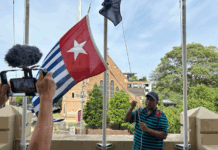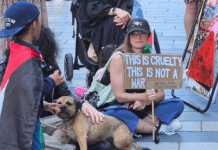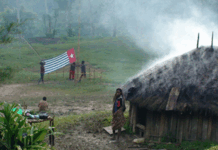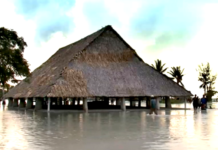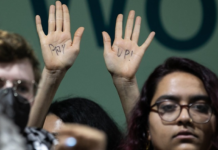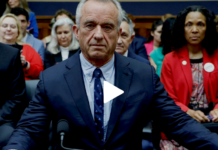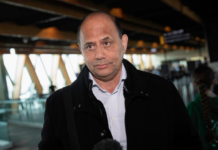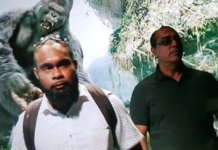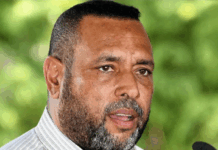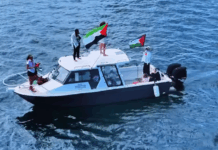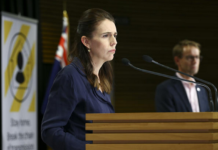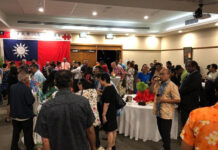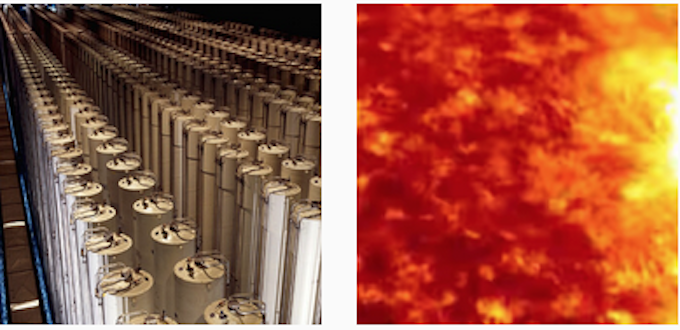
COMMENTARY: By Eugene Doyle
The surprise US-Israeli attack on Iran is literally and figuratively designed to unleash centrifugal forces in the Islamic Republic.
Two nuclear powers are currently involved in the bombing of the nuclear facilities of a third state. One of them, the US has — for the moment — limited itself to handling mid-air refuelling, bombs and an array of intelligence.
If successful they will destroy or, more likely, destabilise the uranium enrichment centrifuges at Natanz and possibly the Fordow Fuel Enrichment Plant, causing them to vibrate and spin uncontrollably, generating centrifugal forces that could rupture containment systems.
- READ MORE: Israel, Iran trade missile fire as Iran’s FM to meet European counterparts
- More Middle East conflict reports
Spinning at more than 50,000 rpm it wouldn’t take much of a shockwave from a blast or some other act of sabotage to do this.
There may be about half a tonne of enriched uranium and several tonnes of lower-grade material underground.
If a cascade of bunker-busting bombs like the US GBU-57 Massive Ordnance Penetrators got through, the heat generated would be in the hundreds, even thousands, of degrees Celsius. This would destroy the centrifuges, converting the uranium hexafluoride gas into a toxic aerosol, leading to serious radiological contamination over a wide area.
The head of the IAEA, the UN’s nuclear watchdog, warned repeatedly of the dangers over the past few days. How many people would be killed, contaminated or forced to evacuate should not have to be calculated — it should be avoided at all cost.
Divided opinions
Some people think this attack is a very good idea; some think this is an act of madness by two rogue states.
On June 18, Israeli media were reporting that the US had rushed an aerial armada loaded with bunker busters to Israel while the US continued its sham denials of involvement in the war.
Analysts Professor Jeffrey Sachs and Sybil Fares warned this week of “Israel bringing the world to the brink of nuclear Armageddon in pursuit of its illegal and extremist aims”. They point out that for some decades now Netanyahu has warned that Iran is weeks or even days away from having the bomb, begging successive presidents for permission to wage Judeo-Christian jihad.
In Donald Trump — the MAGA Peace Candidate — he finally got his green light.
The centrifugal forces destabilising the Iranian state
The other — and possibly more significant — centrifugal force that has been unleashed is a hybrid attack on the Iranian state itself. The Americans, Israelis and their European allies hope to trigger regime change.
There are many Iranians inside and outside the country who would welcome such a development. Other Iranians suggest they should be careful of what they wish for, pointing to the human misery that follows, as night follows day, wherever post 9/11 America’s project to bring “democracy, goodness and niceness” leads. If you can’t quickly think of half a dozen examples, this must be your first visit to Planet Earth.

Is regime change in Iran possible?
So, are the Americans and Israelis on to something or not? This week prominent anti-regime writer Sohrab Ahmari added a caveat to his long-standing call for an end to the regime. Ahmari, an Iranian, who is the US editor of the geopolitical analysis platform UnHerd said: “The potential nightmare scenarios are as numerous as they are appalling: regime collapse that leads not to the restoration of the Pahlavi dynasty and the ascent to the Peacock Throne of its chubby dauphin, Reza, but warlordism and ethno-sectarian warfare that drives millions of refugees into Europe.
“Or a Chinese intervention in favour of a crucial energy partner and anchor of the new Eurasian bloc led by Beijing . . . A blockade of the Strait of Hormuz and attacks on the Persian Gulf monarchies.”
Despite these risks, there are indeed Iranians who are cheering for Uncle Bibi (Prime Minister Benjamin Netanyahu). Some have little sympathy for the Palestinians because their government poured millions into supporting Hamas and Hezbollah — money that could have eased hardship inside Iran, caused, it must be added, by both the US-imposed sanctions and the regime’s own mismanagement, some say corruption.
As I pointed out in an article The West’s War on Iran shortly after the Israelis launched the war: the regime appears to have a core support base of around 20 percent. This was true in 2018 when I last visited Iran and was still the case in the most recent polling I could find.
I quoted an Iranian contact who shortly after the attack told me they had scanned reactions inside Iran and found people were upset, angry and overwhelmingly supportive of the government at this critical moment. Like many, I suggested Iranians would — as typically happens when countries are attacked — rally round the flag. Shortly after the article was published this statement was challenged by other Iranians who dispute that there will be any “rallying to the flag” — as that is the flag of the Islamic Republic and a great many Iranians are sick to the back teeth of it.
Some others demur:
“The killing of at least 224 Iranians has once again significantly damaged Israel’s claim that it avoids targeting civilians,” Dr Shirin Saeidi, author of Women and the Islamic Republic, an associate professor of political science at the University of Arkansas, told The New Arab on June 16. “Israel’s illegal attack on the Iranian people will definitely not result in a popular uprising against the Iranian state. On the contrary, Iranians are coming together behind the Islamic Republic.”
To be honest, I can’t discern who is correct. In the last few of days I have also had contact with people inside Iran (all these contacts must, for obvious reasons, be anonymous). One of them welcomed the attack on the IRGC (Iranian Revolutionary Guard Corps). I also got this message relayed to me from someone else in Iran as a response to my article:
“Some Iranians are pro-regime and have condemned Israeli attacks and want the government to respond strongly. Some Iranians are pro-Israel and happy that Israel has attacked and killed some of their murderers and want regime change, [but the] majority of Iranians dislike both sides.
They dislike the regime in Iran, and they are patriotic so they don’t want a foreign country like Israel invading them and killing people. They feel hopeless and defenceless as they know both sides have failed or will fail them.”
Calculating the incalculable: regime survival or collapse?
Only a little over half of Iran is Persian. Minorities include Azerbaijanis, Kurds, Arabs, Balochis, Turkmen, Armenians and one of the region’s few post-Nakba Jewish congregations outside of Israel today.
Mossad, MI6 and various branches of the US state have poured billions into opposition groups, including various monarchist factions, but from a distance they appear fragmented. The Mojahedin-e-Khalq (MEK) armed opposition group has been an irritant but so far not a major disruptor.
The most effective terrorist attacks inside Iran have been launched by Israel, the US and the British — including the assassination of a string of Iranian peace negotiators, the leader of the political wing of Hamas, nuclear scientists and their families, and various regime figures.
How numerous the active strands of anti-regime elements are is hard to estimate. Equally hard to calculate is how many will move into open confrontation with the regime. Conversely, how unified, durable — or brittle — is the regime? How cohesive is the leadership of the IRGC and the Basij militias? Will they work effectively together in the trying times ahead? In particular, how successful has the CIA, MI6 and Mossad been at penetrating their structures and buying generals?
Both Iran’s nuclear programme and its government — in fact, the whole edifice and foundation of the Islamic Republic — is at the beginning of the greatest stress test of its existence. If the centrifugal forces prove too great, I can’t help but think of the words of William Butler Yeats:
Things fall apart; the centre cannot hold;
Mere anarchy is loosed upon the world,
The blood-dimmed tide is loosed, and everywhere
The ceremony of innocence is drowned;
The best lack all conviction, while the worst
Are full of passionate intensity.
Peace and prosperity to all the people of Iran. And let’s never forget the people of Palestine as they endure genocide.
Eugene Doyle is a writer based in Wellington. He has written extensively on the Middle East, as well as peace and security issues in the Asia Pacific region. He contributes to Asia Pacific Report and Café Pacific, and hosts the public policy platform solidarity.co.nz



